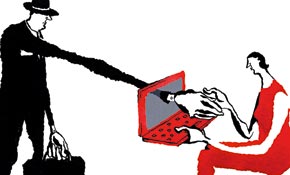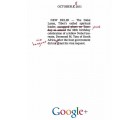
The world of sales has changed, thanks to Google. Remember going into a travel agent to book your holiday? Forget it: the travel website is the future. It’s cheaper and often more convenient. The same is true of print sales – at least in terms of cost. For a fraction of the price, a casual search phrase and a few clicks of a mouse can replace an experienced but expensive salesman hitting the streets and working on prospects. But can online print sales be more effective? That’s the million dollar question.
It seem inevitable that more and more printing companies will do away with sales teams. The internet has killed off the human element to sales in so many industries. But print is different. Product variables are multiple and complex, and the tradition is of face-to-face interaction and close commercial relationships.
But for straightforward jobs bought by the man on the street who hasn’t got even a passing knowledge of stocks and dots, the internet has already taken over. Vistaprint is one such model. The company works for smaller customers buying templated work. It aims very much at the consumer end of the market, but as web-to-print systems grow more sophisticated, this is a direction more print houses will consider. At Vistaprint, small business customers simply place orders for cards and brochures; it’s cheap and it’s delivered without any sales team at all.
It’s an idea that will go against the grain for those industry stalwarts who have grown their business on the back of a savvy sales team. Even members of the copy shop sector aren’t quite ready to ditch their salesforce in preference of a search engine.
David Bell, the managing director of the Kwik Kopy franchise chain, says the Vistaprint model works well for that market, but larger businesses want something more when they buy print.
“You can have anything you want from Vistaprint, as long as it’s in their catalogue,” says Bell. “Their mantra is that if you have to involve humans in the chain of delivery, then you’re likely to be going backwards, not forwards. Ours is the opposite. The beauty of the market is that it so wide and large and there is room for both types of service offering.
“With us, we tell our guys ‘talk to your clients, understand their business and what their needs are and say yes’. Then you can worry about how you produce it.”
Kwik Kopy has an online ordering system but he sees that as distinct from fully fledged automated procurement.
It’s not a 100% online offering. “We do get a number of inquiries from our website requesting quotes but that’s effect-ively an inquiry, it’s not an order per se”
A web inquiry will always be directed to salesperson. “With the request for a quote, it will ask a number of questions and work out where you are and direct the quote to the nearest Kwik Kopy outlet. That would be received by the owner of the relevant centre who would get in contact with you,” he says.
“We have an online ordering system but we try to encourage all our people to recruit sales staff, not ditch them. We don’t operate at the price-sensitive end of the market. We operate at the service end of the market and it is difficult to do that with a purely online capacity.
“You have relationships, you have to meet with people and meet their needs. For us, the online capacity is just a tool that makes it easier for our customers to interact; it’s not the start and the finish of the relationship.”
He says an online system works well when the product is standard and doesn’t change over time. But customers are usually looking for something more.
“They want to have some choice. You identify what their requirements are and give them a number of options to choose from,” adds Bell.
Web ordering can be a false economy. If the client wants something different down the track, then the set-up costs for the artwork would negate the cost benefits of ordering it online. In the end, it’s not cheaper and might end up costing more.
Rival copy shop operation Snap has been focusing heavily on broadening its offering into marketing services. Advertisements pushing its Snap ‘Level 2’ offering adorn buses and billboard at cities around the country (see below). Chief executive Grant Vernon says printers need to capitalise on their relationships with business customers, which takes the human touch.
“If they are a large enough business, those people will often get to a point where they will need help with other things. If you’re going to maximise opportunities with the client, you need to have salespeople who can build those relationships. I think the printers who say this is all so commoditised that there is no need for a client relationship are missing the opportunity to expand those relationships into other areas.”
This is why the company needs sales people, he says. “If you look at Vistaprint, they don’t have salespeople but our business is broader than that and not in a commoditised niche. Because we are looking at a broader service offering where print is just part of it, and in many cases, it’s a by-product of other services, I would see sales as growing in importance rather than diminishing.”
The relationship with the client is crucial, especially for upselling. If a client is setting up a business and puts in an order for business cards, the sales team will check to see whether they need a website as well. How will they do their marketing? Have they considered a newsletter? Email marketing?
“If you are relying on the client being proactive and ordering everything online, you never build a relationship with them and so you never really know what you might be missing out on,” says Vernon.
“And sometimes the client doesn’t understand. Really good salespeople will work with a client and understand where they can add value. The client might not think of something but if we have the opportunity to sit down with them and talk with them about what they want to achieve, that could open up all sorts of possibilities.”
That said, the internet is a key selling tool for Snap, which has made significant investments in its search engine optimisation (SEO) strategy to build its Google rankings. The company recently changed agencies to go with one that had stronger digital capacity. It also works with a search engine optimisation consultancy.
“We have spent a lot of money on Ad Words and trialing all sorts of digital marketing. It provides results,”he says.
It’s not hard to find out which print companies are investing in SEO. Just think about what a customer might search for, stick it in Google and see who appears at the top of the page. One independent print house consistently above the fold on a Google results page is Melbourne-based Discount Printing.
JP O’Neill from Discount Printing says having both an online offering and sales team is critical. “In order to run a successful business, you can’t have one without the other.”
Getting the mix right depends on the size of the deal and the type of deal. “You can have one salesperson who comes in and brings a deal in from the very beginning, then you could bring them in with online technology. Or you can have somebody who could come in over the internet and a salesperson would work with them to a larger extent.”
When orders come in over the internet, he always sends in sales teams to follow up.
A good salesperson is worth their weight in gold – or at least their commission. A strong online presence can reap rewards. But no matter what it is you’re trying to flog, word of mouth is often the best tool.
Brisbane-based CMYK Digital Printing is a case in point. It does large-format printing for the retail industry, with work such as billboards, bus shelters and shopping centre walkways. It does have a presence on the internet (the company name is a bit of a giveaway), but owner Scott Forbes says most business comes in through word of mouth. Online sales are simply not necessary, and he doesn’t need a sales team. The company has been doing this for 21 years.
“If we were an online screen printer, I am sure it would be a fantastic way to do business. But because there is only a handful of companies in the country that do the work we do and because it covers such a wide spectrum, they don’t have to shop around for the right person,” says Forbes.
“Our name keeps getting bounced around from shopping centre group to shopping centre group and that keeps us going all day long every day.”
Madmen Printing, which works largely in the entertainment industry and cinemas, has a similar model. Work keeps coming in through word of mouth. Madmen produces cinema posters, CD and DVD packaging and lots of trade work. The company has a website but says it doesn’t need salespeople or even a search engine optimisation strategy. People know it’s there.
Managing director Dustin Pullin says the company might take on a salesperson if it ever decides to expand. “We’ll probably look at getting someone down the track to knock on a couple of doors but not at this stage.”
Jargon Buster
Search engine optimisation (SEO)
SEO determines how far up the list of results your website is when someone searches on Google or other search engines. It is split into two areas: onsite and offsite. Onsite is all about key words. If you are a brochure printer in Newcastle, you need key words relating to that within the content of your website, so ‘brochures’ or ‘Newcastle printer’. Offsite is basically getting other websites to link to your own, and the more websites that point to your own, the higher your Google ranking.
Pay-per-click
A bit like an auction, if you are willing to pay more than anyone else for someone to click on your ad, then you are at the top of the list on the Google sponsored links area, which is on the right of the main search results page. Your advert will come up when words within it are searched for.
See www.adwords.google.com for more
Case study: Snap Promote
Snap Promote is a new online offering that pits the country’s biggest franchise chain against new arrival Vistaprint.
Vistaprint is to printing what Ikea is to furniture; you do it all yourself. It is a total break from print sales as we know it. Small businesses order online for business cards, posters, letterheads, notepads, flyers and the like. The goods are delivered without any human interaction. There are no sales teams. It is also dirt cheap. A plumber, electrician or sole accountant can order premium business cards for as little as $37.49 (though at the time of writing, premium cards had been discounted to $9.49. It was also giving away 250 standard cards for free).
In response, Snap established Promote last September. The web-to-print offering is part of its plan to grow its revenues by 16% over the next three years. Snap is targeting micro-businesses: the tradies who want to get a quick order in and set themselves up.
Snap has an exclusive deal with publishing software developer Quark to drive the site. Like Vistaprint, Snap Promote features a range of templates for business cards, mailers, tri-fold brochures and other marketing materials.
Customers can just choose a template, download software and tailor the package to suit their needs. Any questions they have are all answered online. It is a complete DIY service.
Snap chief executive officer Grant Vernon is very clear about the market that Snap is targeting. It’s not for small to medium-sized businesses, which have different needs. “The typical user for that sort of business would be very small, like a one-man plumber or electrician or tradie,” says Vernon.
“They want a simple design for business cards, and they want some supporting promotional material. It’s a concrete thing for small businesses that want to use templates.”
Comment below to have your say on this story.
If you have a news story or tip-off, get in touch at editorial@sprinter.com.au.
Sign up to the Sprinter newsletter


